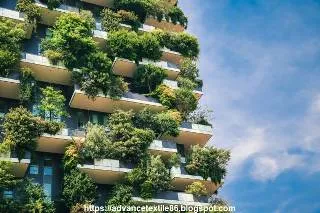Green building
Leadership
in Energy and Environmental Design (LEED) was developed in the United States in
1998. It is the most widely used green building rating system in the world. The
rating system is based on a number of environmental and building-related
criteria on which buildings are rated.
Buildings
contribute to the main environmental impact during their life cycle. Different
resources such as soil, trees, water, and different layouts of energy are used
by the building. Water, for example, is the most important resource that is
constantly consumed during building construction as well as operations.
Similarly, the use of resources, including several buildings, generates large
amounts of waste, which can be recycled and reused. So, the challenge of a
green building is to make the best use of resources and remove the right waste
at an affordable price.
When
designing or constructing a green building, site planning, building envelope
design, integration of renewable energy sources for on-site power generation,
water, and waste management, etc. are considered with utmost importance.
The
construction sector is a big challenge for the environment. Worldwide,
buildings account for at least 40% of energy consumption. Buildings account for
approximately 42% of global water and 50% of global raw material costs when
considering the manufacture, construction, and operation of buildings. In
addition, building activities contribute approximately 50% of the world's air
pollution, 42% of its greenhouse gases, 50% of all water pollution, 48% of all
solid waste, and 50% of all CFCs (chlorofluorocarbons) to the environment.
The principle of green building
Green
Building works on five basic principles like methods, techniques, and practices
are involved and the following is briefly explained-
i.
Sustainable site planning - to optimize land use and to reduce the
environmental footprint of the building.
ii.
Energy efficiency - to establish performance value for intended use,
possession, and other power operation and for new construction reform project.
iii.
Water efficiency - It emphasizes the proper use decreased production of fresh
water and waste landscaping, rainwater harvesting, gray water recycling, and
wastewater treatment system.
iv.
Building Materials - Use of sustainable construction materials and resources,
green building materials improving the overall performance of the building.
v.
Healthy indoor environmental quality- Ventilation and heat comfort, humidity
control, daylighting, environmental tobacco smoke control, and protect indoor
air quality during construction.
Advantages of LEED certification
Economic advantages
i.Approximately
61% of corporate leaders believe that sustainability improves market disparity
and financial performance.
ii.
Leed certified buildings order the highest rents, while lease-up rates
typically average 20% above average; the vacancy rate for green buildings is
approximately 4% lower than for non-green properties.
iii.
It is the world’s leading green building project and performance management
system. It provides a comprehensive framework for green building design,
construction, operation, and performance.
iv.
It helps investors prioritize construction skills, reduce operating costs,
increase asset value and implement management practices to ensure productivity,
comfort, health, and well-being for residents.
v.
Cost-Effectiveness of leed-
-in
energy savings $1.2 billion
-in
water savings $149.5 million
-in
maintenance savings $715.3 million
-in
waste savings $54.2 million
Health advantages
i.LEED-certified
location employers report higher recruitment and retention rates and increased
employee productivity.
ii.
It creates clean air, access to daylight, and a healthy space free from harmful
chemicals found in paints and finishes.
iii.
Improving indoor air quality can reduce working hours affected by absence and
asthma, respiratory allergies, depression, and stress and lead to improved
productivity.
iv.
It makes a critical tool in reducing smog, energy-efficient buildings help
reduce pollution and improve outdoor air quality in major industrialized areas.
Environmental advantages
i.
Expected water storage from LEED commercial buildings is more than 7% of all
non-residential water use.
ii.
Nearly 4 billion vehicle miles of travel have been avoided by LEED building
occupants, thanks to the efficient location and alternative transportation
options.
iii.
By 2030, LEED projects will remove more than 540 million tons of waste from
landfills.
Disadvantages of LEED certification
i.
LEED certification is extremely complex, time-consuming, and costly, adding
$150,000 to the taxpayer-bearing cost for the new federal building, according
to Forbes. The added time and expense, and, at best, unclear results, limits
LEED users to a significant amount of public funding to achieve significant tax
benefits. Which carries the requirements of LEED and for whom financial
accountability is not the main objective. None of these reasons for being
employed in the program guarantee a good environment.
ii. LEED's
applicants are making inadequate claims. Council records show that staff points
that provide courses on green buildings go to employers who provide staff with
a video-game room and fitness center, and builders to install a modern fire
alarm system. LEED v4 is ambitious in weighting and developing credits to
encourage projects to do better than previous attempts to do less bad. However,
there is still no penalty for avoiding necessities with the worst impact on the
environment.
iii. Many
LEED-certified projects meet the standard at the end of construction, but then
fall below that standard because the occupants of the building enter and use
more energy than the designers predicted. LEED certification is not directly
based on energy consumption, so the durability of certified buildings after
construction is sometimes questioned.












0 Comments